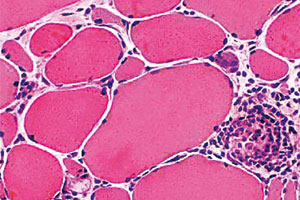The glands of the endocrine system are joined at the head, neck and trunk. From the superior part to inferior part they are: the hypothalamus, hypophysis, thyroid gland, parathyroid glands, pancreas, suprarenal glands and gonads (testicles and ovaries). They, along with other organs (heart, kidneys, intestines, among others) that are not functionally endocrine glands, produce hormonal substances that keep the body under control.
Hypothalamus-Hypophysis axis
The hypothalamus and hypophysis (or pituitary gland) make up a functional unit known as hypothalamus-hypophysis axis, which coordinates a fair share of the endocrine system’s activity.
The hypothalamus is a structure of the diencephalon (in the center of the brain) that contains some cells specialized in the production of certain hormones.
It is the main link between the nervous and endocrine systems.
The hypophysis is a portion of the brain that is set over the sphenoid bone, underneath the hypothalamus. It is made up of two lobes, which secrete different hormones into the blood that control most of body’s endocrine glands: the anterior or adenohypophysis and the posterior or neurohypophysis.
The hypophysis also controls the secretion of hormones of the rest of the endocrine glands through a mechanism called feedback, where, for example, the levels of hormone “A” in the surrounding blood indicate to the hypophysis gland it should send some «B» hormones, to lower or raise the concentration of “A” hormones and thus maintain the balance within the body.
Glands of the neck and trunk
The thyroid is a butterfly-shaped gland that is located in the inferior part of the neck.
It is made up of two lobes, right and left, joined by a structure called isthmus. It measures approximately five centimeters wide, four long and one in girth and weighs between 20 and 60 grams. It secretes three hormones that affect the body’s growth and development: thyroxin or tetraiodothyronine or T4, triiodothyronine or T3 and calcitonin. Their functioning is stimulated by the thyrotropin hormone of the hypophysis.
Behind the thyroid we find two pairs of glands known as parathyroid glands. They have a function that is complementary to the thyroid. They produce a single hormone, parathormone o parathyroid hormone.
The pancreas is an organ that carries out a double function: to secrete enzymes towards the duodenum that help breakdown nutrients –as we saw in the chapters devoted to the digestive system and the digestive process- and to work as an endocrine gland. The pancreas performs this last task from the Islets of Langerhans, which are groupings of cells spread throughout the inside of the organ and manufacture and pour three hormones into the blood: insulin, glucagon and somatostatin
The suprarenal or adrenal glands are two small endocrine structures located in the superior part of each kidney.
Each one of them is formed by an inner area called medulla and an external area called cortex. These sections perform different functions and secrete different hormones.
Other hormone producing organs
There are some organs in different parts of the body that secrete hormones, despite not being endocrine glands.
The heart produces a hormone known as atriopeptin, which helps maintain the balance of fluids that reduce the pressure and volume of blood.
The stomach and intestines secrete hormones that control the processes of digestion. This is how we find gastrin, which makes the stomach produce hydrochloric acid in order to dissolve some foods; secretin, which is formed in the duodenum and increases the amount of pancreatic juices and bile; cholecistocinine, which stimulates the secretion of digestive juices when fats and proteins are being digested, and serotonin, which acts upon the musculature of the digestive apparatus, stimulating its contraction.
The kidneys secrete erythropoietin, which stimulates the production of red blood cells in bone marrow. It also secretes rennin, which helps control blood pressure by stimulating the production of angiotensin, manufactured in another organ, the liver.








 Termina la Guerra de Corea
Termina la Guerra de Corea